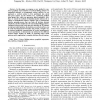Free Online Productivity Tools
i2Speak
i2Symbol
i2OCR
iTex2Img
iWeb2Print
iWeb2Shot
i2Type
iPdf2Split
iPdf2Merge
i2Bopomofo
i2Arabic
i2Style
i2Image
i2PDF
iLatex2Rtf
Sci2ools
TMI
2008
2008
Hamilton-Jacobi Skeleton on Cortical Surfaces
Abstract-- In this paper, we propose a new method to construct graphical representations of cortical folding patterns by computing skeletons on triangulated cortical surfaces. In our approach, a cortical surface is first partitioned into sulcal and gyral regions via the solution of a variational problem using graph cuts, which can guarantee global optimality. After that, we extend the method of Hamilton-Jacobi skeleton [1] to subsets of triangulated surfaces, together with a geometrically intuitive pruning process that can trade off between skeleton complexity and the completeness of representing folding patterns. Compared with previous work that uses skeletons of 3D volumes to represent sulcal patterns, the skeletons on cortical surfaces can be easily decomposed into branches and provide a simpler way to construct graphical representations of cortical morphometry. In our experiments, we demonstrate our method on two different cortical surface models, its ability of capturing major sul...
| Added | 15 Dec 2010 |
| Updated | 15 Dec 2010 |
| Type | Journal |
| Year | 2008 |
| Where | TMI |
| Authors | Yonggang Shi, Paul M. Thompson, Ivo D. Dinov, Arthur W. Toga |
Comments (0)

